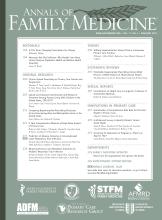In 2015, Entrustable Professional Activities (EPAs) for the specialty of family medicine were developed and approved by the organizations supporting Family Medicine for America’s Health: the Council of Academic Family Medicine (Association of Departments of Family Medicine, Association of Family Medicine Residency Directors, North American Primary Care Research Group, Society of Teachers of Family Medicine), the American Academy of Family Physicians, the American Academy of Family Physicians Foundation, the American Board of Family Medicine, and the American College of Osteopathic Family Physicians.
EPAs have been proposed as part of competency-based education for the last decade or so, and they can be thought of as discrete units of work, which in aggregate can define a profession or a specialty. In this way they are much broader and overarching descriptors of physician performance than milestones. The 20 EPAs for family medicine are meant to represent the skill set of a graduating family medicine resident.
Following the approval of the family medicine EPAs, the Association of Family Medicine Residency Directors (AFMRD) formed an EPA Task Force, comprised of program directors and associate directors from rural, community and university-based programs from around the United States. Their goal was to develop resources and tools that would help family medicine residencies use EPAs to improve education and help achieve the goal of clarifying for society and practices what they can expect from graduating family medicine residents. To accomplish this first required a close examination of each of the EPAs and a firm understanding of the needs of program directors.
Members of the EPA Task Force had the opportunity to meet with many program directors at the 2016 Program Directors Workshop, during which they heard program directors voice concerns that the EPAs would be another layer of reporting or an additional measurement tool just as they were becoming accustomed to milestones. Considering that neither the ABFM nor the RC-FM is interested in requiring reporting of the EPAs at this time, the task force aimed to help residency directors see the ways the EPAs can be used to their own advantage.
In short, there are 3 main ways in which program directors may find EPAs valuable.
First, is to improve resident evaluation. As clear descriptors of resident work it can be easier for many of our faculty to evaluate residents based on EPAs rather than sub-competencies or milestones. (The task force developed mapping documents that will allow programs to translate evaluations based on EPAs to milestones and sub-competencies.)
The second way that EPAs can be valuable is as curricular evaluation tools. Programs may use EPAs as a lens through which to examine the program curriculum and perhaps discover areas of improvement.
The third way that EPAs can be useful is as concrete descriptors of expectations of resident performance. Describing for a community attending the role of the resident using EPA language can be much clearer than using the sub-competencies or milestones language.
The EPA Task Force has developed tools to support such use of the EPAs in a residency program. Working with members of the residency education community across the country, the group reviewed the EPAs and drafted materials using a standardized method. This work resulted in a detailed report on each EPA, including interpretation, methods for measuring entrustment, and identification of milestones as well as a mapping grid of the EPAs and associated milestones.
To ensure the EPAs’ usefulness in evaluation, resident learning plan creation, and curriculum review and design, subgroups of the task force were commissioned to address each of these areas through a white paper and a slide set.
The documents developed by the task force are currently available on the AFMRD website; task force members are scheduled to present their findings at national and regional meetings throughout 2017.
It is hoped that EPAs and the supporting resources developed by the EPA Task Force will be the next step in competency-based education for family medicine residents, and that through the use of these tools, programs and residents will feel better prepared to tackle the health care challenges of the 21st century.
- © 2017 Annals of Family Medicine, Inc.







